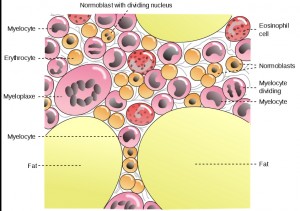Secondary myelofibrosis – Etiology, Pathogenesis, Investigations and Management

Normal bone marrow
Click on image for an enlarged view
- Myelofibrosis refers to replacement of normal bone marrow constituents by fibrous tissue
- Secondary myelofibrosis occurs as a result of various pathological processes that involve the bone marrow
Causes of secondary myelofibrosis:
- Neoplastic – infiltration by cancer cells (primary is usually located in breast, lung or prostate)
- Infective – tuberculosis, fungal infections, HIV
- Metabolic – Gaucher’s disease
- Hematological malignancies – chronic myeloid leukemia, multiple myeloma, lymphomas
- Radiation, radiomimetic drugs
- Others – Sarcoidosis, congenital osteopetrosis
Pathophysiology:
- Marrow contents are replaced by fibrous tissue
- There is extramedullary hematopoiesis in sites like spleen and liver
- Increased number of circulating hematopoietic progenitor cells
Investigations:
- Bone marrow aspiration gives a ‘dry tap’ – no cells are obtained
- Bone marrow biopsy reveals fibrosis of bone marrow
- Peripheral smear
- anemia – normocytic, normochromic
- leukoerythroblastosis – blast forms of RBC’s and WBC’s
Management:
- Treat the underlying condition
- Bone marrow transplantation



